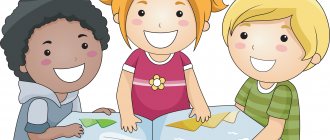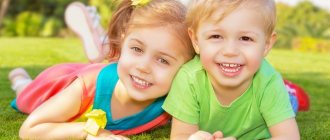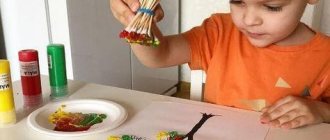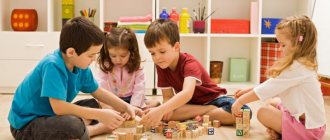The importance of cognitive and speech development
Definition 1
Speech is a special form of communication and interaction between people, during which they exchange thoughts, ideas, experiences and other information with each other, and also influence each other.
Speech is a clear indicator of a child’s development. If speech is poorly developed, then it contains a number of characteristic errors, such as poor vocabulary, incorrect construction of sentences, inability to logically connect words to express one’s thoughts, defects in pronunciation, inconsistent rhythm of speech, etc.
The better a preschool child’s speech is developed, the more successful the learning will be during his school years. However, a child’s speech is not always well developed in the preschool period. This is largely due to the fact that ineffective methods and methods for its development were chosen. It has now been proven that the success of speech development of a preschool child is facilitated by the organization of simultaneous cognitive development with speech. This is achieved through various types of activities: gaming, work, educational and cognitive, communicative, etc. It is also important that during the activity the child must actively express his thoughts, feelings, sensations, etc.
Are you an expert in this subject area? We invite you to become the author of the Directory Working Conditions
Speech, which is accompanied by cognitive activity, makes it more conscious and purposeful. The teacher’s task is to help the child achieve the necessary communicative competence by the end of preschool childhood. This is achieved through properly organized cognitive and speech development of preschool children in all age groups. An important condition is compliance with the following components:
- competent and correct speech of the teacher;
- developing children's ideas about the world around them and life in it;
- development of curiosity, activity and initiative in children;
- sensory education;
- varied and rich play activities.
The significance of the cognitive and speech development of preschool children lies in the fact that currently more and more preschool children have problems in the development of speech activity. These problems are caused by the following negative factors:
- Deterioration in the physical and mental health of children.
- A significant decrease in “live” communication between children and peers and adults, including parents.
- A significant decline in the level of speech culture in modern society.
- Insufficient attention on the part of adults (parents, educators) to the speech development of children.
Finished works on a similar topic
Course work Cognitive and speech development of preschool children 430 ₽ Abstract Cognitive and speech development of preschool children 220 ₽ Test work Cognitive and speech development of preschool children 220 ₽
Receive completed work or specialist advice on your educational project Find out the cost
Speech development of preschool children in cognitive research activities
author: Ardatova Tatyana Nikolaevna
teacher of MB preschool educational institution "Kindergarten No. 88"
Speech development of preschool children in cognitive research activities
Speech development of preschool children in cognitive research activities
Personal self-development is possible only in activities that include not only the external activity of the child, but also the internal psychological basis.
Improving the cognitive activity of preschool children is one of the most important tasks in pedagogy. After all, if we want to raise an intellectually developed person, then we need to create conditions for her self-development. It is necessary to develop cognitive and research activities in children to activate their curiosity, inquisitiveness and increase interest in everything. Cognitive and research activities are aimed at: developing speech, obtaining new knowledge, assimilating it, mastering the necessary skills and abilities, and developing the ability to reproduce and apply acquired knowledge. It is quite possible for a younger preschooler to develop the makings of a researcher. Children of this age are characterized by a high interest in everything that happens around them. Every day on their way they encounter new objects, which children compare, learn the names of, and strive to remember. By maintaining children's interest in everything new, you can constantly stimulate their cognitive activity and develop the child's speech.
Experimentation in preschool age is aimed at developing in children the ability to independently obtain information about a new object. All senses are actively used for experiments.
Children's experimentation, as a method in pedagogical work, is highly effective and indispensable for the development of preschoolers' research activities, cognitive activity, increasing the amount of knowledge, skills and abilities and, of course, speech development.
Preschoolers are born researchers; the constant desire to experiment, the desire to independently find a solution to a problem situation contributes to mental activity and develops children’s speech.
Therefore, we set a goal: creating conditions for the development of speech in preschoolers through cognitive research activities. Tasks identified:
- contribute to the enrichment of children's active vocabulary through cognitive and research activities.
- develop the ability to establish simple connections between objects and phenomena and make generalizations.
- develop observation, the ability to analyze, compare, and identify characteristic features of objects and phenomena of the surrounding world.
- involve parents in joint research activities with children, promoting the speech activity of preschoolers.
When organizing the cognitive and speech development of children, I rely on
the following directions:
- improving your own speech. The teacher’s speech must be literate, and most importantly, intelligible and understandable to children.
- formation of ideas about the surrounding world.
In life, people have to solve a variety of problems. To cope with problems, you need to learn to solve them yourself. Therefore, we try to structure educational activities in such a way that children feel like researchers. And to do this, we create a problem situation in which children make assumptions about what they will study during the activity. In conversation, they discover new knowledge, determine whether their assumptions are correct, explain what they learned, and learn to evaluate how they performed.
Next direction: developing curiosity. When organizing activities and observations, we try to answer questions that arise in a timely manner and in an understandable language; we direct children’s thoughts to an independent search for an answer and the ability to draw conclusions. In order to consolidate ideas about the relationships in nature, to familiarize children with objects and natural phenomena, we regularly conduct targeted walks and observations of natural objects and phenomena.
Game is one of the most effective means of cognitive and speech development. In the game, children master the skills of operating with certain objects and learn the culture of communication with each other.
Research activities take place in a free, practically
not regulated by any external settings or time forms.
We regularly observe objects and natural phenomena, then discuss them with children; we look at illustrations in books with scientific content, children's encyclopedias; We get acquainted with the materials of the children's mini-laboratory.
We use the following situations for the development of speech in the cognitive research activities of preschoolers: real events occurring in a given period: 1) vivid natural phenomena (for example: description of leaf fall, snowfall); 2) social events (for example: an upcoming holiday); 3) specially created situations (for example, displaying objects with an unusual effect or purpose “What is this? What to do with it? How does it work?”).
Such items can be: a magnet, a collection of some things, postcards, stickers on a certain topic. The stimulus for research can be events occurring in the life of the group, “infecting” most of the children and leading to stable interests and reasoning (for example, someone brought their collection of stickers, robots, dinosaurs, collecting chips, etc.), organization joint experiments and research with children in everyday life.
Experimental games are a special group of games that are very effective in solving cognitive and speech problems, as well as interesting and exciting for preschoolers. During the experiment, the child’s memory is enriched, his thought processes are activated, and speech develops, since the need constantly arises to perform operations of analysis, comparison, classification, and generalization. As a result of children’s assimilation of cause-and-effect relationships, children’s vocabulary is enriched and the grammatical structure of speech improves (formation of adjectives from nouns, formation of the plural of nouns). The development of such a type of coherent speech as a descriptive story.
Cognitive research activity is one of the most frequently used methods in working with children. (after play activity). We are not even always aware of how often we use cognitive research activities in everyday life. From the very morning, starting with observations in a corner of nature, we experiment, explore, increase the amount of knowledge, skills, develop speech and cognitive activity. In every lesson we explore something. For example, classes in fine arts. The water for brushes is clear, it has no color, but when we rinse the brush, it becomes colored.
Why do airplanes made from landscape sheets fly worse than those made from notebook sheets? Observations during the walk: frost, snow creaks underfoot, thaw, snow sticky. Catch a snowflake on a mitten and examine it. You can take out the magnifying glass. Then, if you catch a snowflake in your palm, what happens to it? Why doesn’t a snowflake melt on a mitten, but on your palm? When are footprints clearly visible in the snow? Why does the snow fall into snowdrifts in winter, but not closer to spring? When and why does crust form? Why do icicles appear? Children formulate their answers, build sentences, expressing their opinions.
To maintain children's interest, we conducted a number of experiments. Here are some of them:
- Experiments with water: water is a very interesting object for kids to study. For your information! During these experiments, we drew the children's attention to the fact that water can be in three states: liquid, solid and gaseous.
Experience “Turning snow into water”
They brought a bucket of snow from the street. We remembered what happens to snow in warm weather. It's cold outside, but the room is warm. The snow melts - it becomes
less, but more water. The water is cold at first, but after a while it warms up. Snow, ice, icicles melt in the room from the heat and turn into water.
Cognitive and research activities develop vocabulary by introducing into children’s speech the designations of new phenomena and objects and their descriptions. As a result of careful pronunciation and memorization, phonetic skills are trained. Descriptions of the joint activities carried out help us introduce correct grammatical forms into children's speech, develop communication skills and conversational speech.
Research on the topic "Volcano"
The children asked to tell them about volcanoes after we read the book “Terrible and Alluring Volcanoes” by Rimma Petrovna Aldonina. We looked at the illustrations in the book, looked at the illustrations in the Pochemuchki encyclopedia, and learned a lot of interesting things. The group has a model of a volcano, together with the children we found out that: “A volcano looks like a cone, lava erupts from it, volcanoes are dormant, extinct, active. People who study volcanoes are called volcanologists.”
Volcanoes erupt in different ways. Sometimes they seem to explode, throwing magma up and to the sides. A huge mountain shakes with a terrible roar, a huge cloud of smoke and ash rises above it, and stone rain showers the slopes. And sometimes it flows out “calmly.” The children and I observed these eruptions on slides: 1) lava erupting from a volcano turns into pumice; 2) group study: “Pumice is a stone”; 3) material: a bowl of water, stones and a piece of pumice.
Children carefully examine the stones and pumice. They compare them with each other: there are a lot of holes in pumice. Question: are the holes empty or is there something in them? (air is hidden in the holes, so pumice is lighter than regular stone). We lower a piece of pumice into a bowl of water: are there any bubbles, does the pumice sink or float? Why?
The children make a discovery together with us: pumice is a stone, there are many holes in it, air accumulates in them. Pumice does not sink, but floats on the surface of the water.
This study clearly shows that the cognitive and research activity of a child presupposes the development of his thinking, perception, speech and understanding, the ability to generalize and analyze.
Experiment “Steam is also water.”
We heated the water and saw the steam rise up. They covered the vessel with a lid, lifted the lid and showed how the steam turns back into drops and falls down.
Peer dialogue is of primary importance in the speech development of preschool children. It is here that children truly feel equal, free, and relaxed. Here they learn self-organization, initiative, and self-control. We use dialogues for children to discuss new experiences gained during research sessions.
Experiments with paper
It would seem, what unusual could be in paper? Children see it every day, use it in art classes and make crafts and cards from it. But how surprised they were to learn so many new things about her.
Experiment “The influence of water on paper”
We took different types of paper that we had on hand: table napkins; album sheet; magazine cover; paper handkerchiefs; cardboard. Cut pieces of approximately equal size and put them in a container with a small amount of water. It is clearly visible that corrugated paper, napkins, paper handkerchiefs, newspaper absorb water very well, and subsequently completely spread out in the tray. Cardboard and album sheets absorb water a little worse, as they are denser.
After this experiment, we connected the property of paper to tear with its property of soaking quickly or slowly in water; the children very quickly concluded that those types of paper that water soaks faster tear much easier. But a magazine cover, cardboard, or wallpaper are more difficult to tear. By drawing conclusions and formulating their answers, children learn to construct sentences correctly, their vocabulary is activated, coherent speech develops, and the grammatical structure of speech is improved.
Well, now we will create a “garden on the window”. This is also an educational research activity. Why do we always plant peas or beans? Because it is best to follow how the process occurs. The pea is very hard, wrinkled, children touch the pea and feel it. Then we soak for germination. The pea swells, becomes smooth, soft, and most importantly, the sprout is very clearly visible in it. Children see all this, understand how a sprout sprouts. Then we plant it in the ground and wait for it to sprout. It is very important for the development of speech in cognitive research activities to use the bad word. For example, “On the ridge a carrot will be born.” Will the candies grow or not? Why? Where do candies come from then? What are they made of? Where does sugar come from? Chocolate?
Experience with a bow. (how onions grow in a dark and light place)
We are not even always aware of how often we use cognitive research activities in everyday life.
It is very important to develop not only the child’s mental activity, but also not to forget about the development of speech. Speech development of preschool children in cognitive research activities
The purpose and objectives of cognitive and speech development
The leading goals of cognitive and speech development are:
- Timely and comprehensive development of the child’s personality.
- Introducing the child to universal and cultural values.
- Formation and development of curiosity and creative imagination as the basis of a child’s cognitive activity.
The tasks of cognitive and speech development of preschool children are:
- Formation of cognitive processes and methods of mental activity, expansion and enrichment of knowledge about the surrounding world and nature.
- Involving parents (guardians) of pupils in joint activities with children (research, design, educational, etc.).
- Promoting the activation of the child’s speech activity in everyday and practical activities.
- Organization and improvement of the subject-development environment of preschool educational institutions, aimed at the cognitive and speech development of children.
Note 1
One of the most important areas of cognitive and speech development is the timely and successful acquisition by a child of his native language. This is due to the fact that native speech helps the child to understand the world around him, acquire the necessary skills and abilities, and acquire practical experience.
In addition, the development of a child’s speech is largely connected with knowledge of the world around him, the development of his own cognition and personality, understanding of his “I” and his position in this world. The existence of a child in society contributes to the formation of speech, since only through communication can a child interact productively with people around him.




